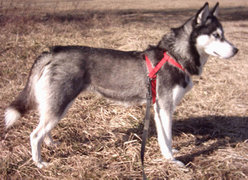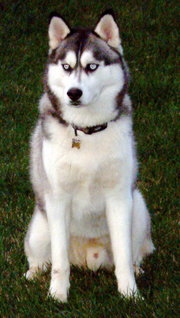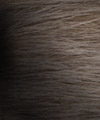Siberian Husky
A working dog breed that originated in eastern Siberia, the Siberian Husky is a medium-sized dog, 35 to 60 pounds (16 to 27 kg) in weight, 20 to 23. more...
5 inches (51 to 60 cm) in height, originally bred by the Chukchi tribes for use as a village dog, herding the reindeer, pulling sledges, and guarding the women and children.
Appearance
Siberians have a dense double-layer coat that comes in a variety of colours and patterns, usually with white feet and legs, facial markings, and tail tip. The most common colors are black and white, grey and white, copper red and white, and pure white, though many individuals have brown, reddish, or biscuit shadings and some are piebald spotted. Striking masks, spectacles, and other facial markings occur in wide variety.
Eyes
Their eyes are brown, hazel, or blue. The light blue eye colour is characteristic but incompletely dominant. The breed may have one eye brown or hazel and the other blue, or may have blue and another colour mixed in the iris of one or both eyes; this latter trait is sometimes called "bi-eyed" by Siberian enthusiasts. This might be the only breed for which different-colored eyes are allowed in the show ring.
Ears
Its ears are triangular, well-furred, and erect; its fox-like brush tail is carried in a sickle curve over the back.
Coat
The Siberian Husky's coat consists of two layers, a dense, cashmere-like undercoat and a longer coarser topcoat consisting of straight guard hairs. Siberians usually shed their undercoat once or twice a year, producing prodigious quantities of fur; the process is commonly referred to as blowing their coat. Dogs that live primarily indoors often shed year round, so the shedding is less profuse—but constant. Therefore, an owner might have a Siberian that sheds lightly all year, or a Siberian that blows its complete coat twice a year. A strong steel comb helps in removing the dense handfuls of hair that come loose while the dog is blowing its coat. Otherwise, grooming is minimal; bathing is normally unnecessary as the coat sheds dirt. Well and healthy Siberians have no odor.
Temperament
Popular as family pets and as show dogs due to their striking appearance and gentle temperament, Siberians have certain drawbacks. Although normally quite tractable, affectionate and docile with people, they have a strong hunting drive and will kill cats, rabbits, chickens, squirrels and other birds and small animals; they have been known to savage sheep. They should be kept in secure enclosures as they will not always come to call and will often disappear on long hunting trips; they cannot be allowed to run loose. Siberians are also accomplished escape artists and diggers, so it is important to check enclosures frequently for any potential escape routes. Siberians are trainable to a certain degree, but patience is necessary. They are independent in nature and not given to blind obedience to every command.
Read more at Wikipedia.org



